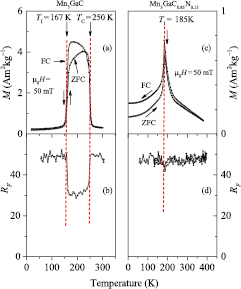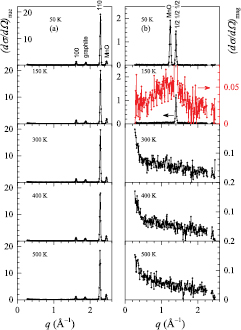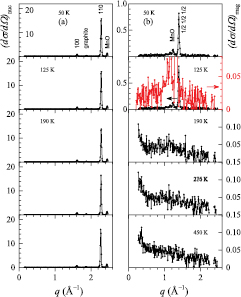Abstract
Partially substituting carbon by nitrogen in the antiperovskite compound Mn3GaC increases the first order antiferromagnetic/ferromagnetic transition temperature and at the same time causes the high-temperature long-range ferromagnetism to weaken. To show that the weakening is related to the diminishing of ferromagnetic domain formation, we undertake neutron depolarization and neutron polarization analysis experiments on Mn3GaC and Mn3GaC0.85N0.15. Polarization analysis experiments show that strong ferromagnetic correlations are present at high temperatures in the paramagnetic states of both Mn3GaC and Mn3GaC0.85N0.15 and that these correlations vanish in the antiferromagnetic state. Neutron depolarization studies show that above the first order transition temperature, ferromagnetic domain formation is present in Mn3GaC but is absent in Mn3GaC0.85N0.15. The relationship between ferromagnetic domain formation and transitional hysteresis is brought forward for these two important magnetocaloric materials.
Export citation and abstract BibTeX RIS
The magnetocaloric effect (MCE) describes the adiabatic temperature change  of materials produced by the magnetic entropy change
of materials produced by the magnetic entropy change  on applying a magnetic field. Due to potential applications as refrigerants, materials showing large adiabatic temperature-change have attracted considerable attention [1–4]. Large or giant MCE has been observed around first-order and second-order magnetic phase transitions [5]. However, the practical application of first-order magnetic phase transitions for the MCE is restricted because of the thermal hysteresis of the transition. Recently, Mn-based antiperovskite compounds with the general formula Mn3AX, where X is C, N or B, and A is a group 13-15 element, have attracted considerable attention because of their narrow hysteresis properties [6–11].
on applying a magnetic field. Due to potential applications as refrigerants, materials showing large adiabatic temperature-change have attracted considerable attention [1–4]. Large or giant MCE has been observed around first-order and second-order magnetic phase transitions [5]. However, the practical application of first-order magnetic phase transitions for the MCE is restricted because of the thermal hysteresis of the transition. Recently, Mn-based antiperovskite compounds with the general formula Mn3AX, where X is C, N or B, and A is a group 13-15 element, have attracted considerable attention because of their narrow hysteresis properties [6–11].
Previous studies on the adiabatic temperature change in Mn3GaC and Mn3GaC0.85N0.15 show similar adiabatic temperature changes. However, the thermal hysteresis observed in Mn3GaC disappears in Mn3GaC0.85N0.15 [12, 13]. This result may suggest that the presence of ferromagnetism could be related to hysteresis.
These materials are ordered in a cubic symmetry having the Pm3m space group. The Mn atoms are located at the face centered positions, the A atoms at the cube corners, and the X atoms at the octahedral site at the cube-center [14]. Among the antiperovskite compounds, Mn3GaC has two magnetic transitions: a first-order antiferromagnetic (AF) to ferromagnetic (FM) magnetostructural transition at  K and a second-order FM to paramagnetic (PM) transition at the Curie temperature
K and a second-order FM to paramagnetic (PM) transition at the Curie temperature  K. The width of the thermal hysteresis of the transition is about 4 K. In our earlier work, Mn3GaC0.85N0.15 was produced by replacing interstitial carbon by nitrogen [13]. It was observed that the transition occurred from a high temperature an enhanced paramagnetic (EPM) state to a low temperature AF state, i.e. before
K. The width of the thermal hysteresis of the transition is about 4 K. In our earlier work, Mn3GaC0.85N0.15 was produced by replacing interstitial carbon by nitrogen [13]. It was observed that the transition occurred from a high temperature an enhanced paramagnetic (EPM) state to a low temperature AF state, i.e. before  is reached, a transition to the AF state occurs at
is reached, a transition to the AF state occurs at  , below which the magnetization rapidly decreases. The long-range ordered FM state which is observed in Mn3GaC is not present.
, below which the magnetization rapidly decreases. The long-range ordered FM state which is observed in Mn3GaC is not present.
In this work, we have conducted neutron depolarization analysis and XYZ-polarization analysis experiments on Mn3GaC and Mn3GaC0.85N0.15 to study the nature of magnetic correlations and to verify the presence of the EPM state suggested by the results of magnetization measurements.
Polarization-analysis experiments were conducted on annealed powder samples on the D7 diffuse-scattering spectrometer at the Institut Laue-Langevin, Grenoble using 4.86 Å incident neutrons. This instrument allows full XYZ-polarization analysis to separate the nuclear-coherent, magnetic, and spin-incoherent cross-sections, (dσ/d )nuc, (dσ/d
)nuc, (dσ/d )mag, and (dσ/d
)mag, and (dσ/d )inc solely from geometrical-scattering conditions [15–17]. The cross-sections are corrected for detector and analyzer efficiency via a vanadium and a quartz sample, respectively. The absolute cross-sections are determined by comparative scattering of a vanadium sample. The flipping ratio
)inc solely from geometrical-scattering conditions [15–17]. The cross-sections are corrected for detector and analyzer efficiency via a vanadium and a quartz sample, respectively. The absolute cross-sections are determined by comparative scattering of a vanadium sample. The flipping ratio  of the neutrons traveling through the sample have also been measured. A polarizer and a flipper placed before the sample determines the up or down polarization of the neutron spin at the sample, and an analyzer and a detector on the main beam after the sample counts the incoming up-spin polarized neutrons.
of the neutrons traveling through the sample have also been measured. A polarizer and a flipper placed before the sample determines the up or down polarization of the neutron spin at the sample, and an analyzer and a detector on the main beam after the sample counts the incoming up-spin polarized neutrons.  is defined as the ratio of the spin-up to spin-down eigenstates and is a measure of the neutron depolarization. Here, we define it as
is defined as the ratio of the spin-up to spin-down eigenstates and is a measure of the neutron depolarization. Here, we define it as

where  and
and  are the number of up-spin and down-spin neutrons arriving at the detector. In a sample with zero net magnetization,
are the number of up-spin and down-spin neutrons arriving at the detector. In a sample with zero net magnetization,  is not affected by the sample. However, if a sample has FM domains, a neutron spin will experience a torque causing it to precess around the magnetization direction of the FM domains that are inhomogeneously distributed across the beam profile. This causes a depolarization of the neutron state with a resultant drop in
is not affected by the sample. However, if a sample has FM domains, a neutron spin will experience a torque causing it to precess around the magnetization direction of the FM domains that are inhomogeneously distributed across the beam profile. This causes a depolarization of the neutron state with a resultant drop in  . The depolarization measurement is therefore a sensitive tool for determining the presence of FM domains.
. The depolarization measurement is therefore a sensitive tool for determining the presence of FM domains.
The results of the depolarization experiments are shown in figure 1. The temperature dependence of the magnetization M(T) and  for Mn3GaC are shown figures 1(a) and (b) respectively. Similarly, M(T) and
for Mn3GaC are shown figures 1(a) and (b) respectively. Similarly, M(T) and  for Mn3GaC0.85N0.15 are shown figures 1(c) and (d). For Mn3GaC, at 350 K, well in the PM state,
for Mn3GaC0.85N0.15 are shown figures 1(c) and (d). For Mn3GaC, at 350 K, well in the PM state,  is
is  50 until down to
50 until down to  , below which it decreases sharply to a value of 30. This is related to FM ordering below
, below which it decreases sharply to a value of 30. This is related to FM ordering below  where the beam is depolarized by the FM domains. This value remains constant until
where the beam is depolarized by the FM domains. This value remains constant until  , below which
, below which  regains its maximum initial value of
regains its maximum initial value of  50. This indicates that FM ordering breaks down in agreement with M(T). On the other hand, in Mn3GaC0.85N0.15,
50. This indicates that FM ordering breaks down in agreement with M(T). On the other hand, in Mn3GaC0.85N0.15,  is temperature independent running at its maximum value. This shows that FM domains do not develop in this sample as
is temperature independent running at its maximum value. This shows that FM domains do not develop in this sample as  is approached from high temperatures, although a tendency towards FM ordering is observed in M(T). Therefore,
is approached from high temperatures, although a tendency towards FM ordering is observed in M(T). Therefore,  separates an enhanced paramagnetic state (EPM) from the low-temperature AF state.
separates an enhanced paramagnetic state (EPM) from the low-temperature AF state.
Figure 1. Characterization of the samples for the polarization analysis experiments of Mn3GaC and Mn3GaC0.85N0.15. (a) M(T) in the ZFC and FC states under 5O Oe for Mn3GaC (b)  for Mn3GaC. (c) M(T) in the ZFC and FC states under 5O Oe for Mn3GaC0.85N0.15 (d)
for Mn3GaC. (c) M(T) in the ZFC and FC states under 5O Oe for Mn3GaC0.85N0.15 (d)  for Mn3GaC0.85N0.15.
for Mn3GaC0.85N0.15.
Download figure:
Standard image High-resolution imageTo examine closer the nature of magnetic coupling below and above  we have undertaken neutron polarization analysis studies on both samples. We study in both systems the nature of both short and long range magnetic ordering below and above
we have undertaken neutron polarization analysis studies on both samples. We study in both systems the nature of both short and long range magnetic ordering below and above  .
.
The result of the polarization analysis experiments on Mn3GaC and Mn3GaC0.85N0.15 are shown figures 2 and 3, respectively, where (dσ/d )nuc and (dσ/d
)nuc and (dσ/d )mag are plotted as a function of the wave vector q up to 2.5 Å−1.
)mag are plotted as a function of the wave vector q up to 2.5 Å−1.
Figure 2. q dependence of the neutron-scattering cross-sections in the paramagnetic and AF state of Mn3GaC (a) The nuclear cross-section plotted in the range  (b) The magnetic cross-section. The forward scattering in the paramagnetic state is decreasing distinctly in the AF state.
(b) The magnetic cross-section. The forward scattering in the paramagnetic state is decreasing distinctly in the AF state.
Download figure:
Standard image High-resolution imageFigure 3. q dependence of the neutron-scattering cross-sections in the EPM state of Mn3GaC0.85N0.15. (a) The nuclear cross-section plotted in the range  . (b) The magnetic cross-section.
. (b) The magnetic cross-section.
Download figure:
Standard image High-resolution image(dσ/d )nuc versus q for Mn3GaC is plotted in figure 2(a) showing diffraction patterns at different temperatures. The patterns include (1 0 0) and (1 1 0) reflections related to the antiperovskite cubic structure and other reflections belonging to graphite and MnO phases in the sample.
)nuc versus q for Mn3GaC is plotted in figure 2(a) showing diffraction patterns at different temperatures. The patterns include (1 0 0) and (1 1 0) reflections related to the antiperovskite cubic structure and other reflections belonging to graphite and MnO phases in the sample.
(dσ/d )mag versus q are given in figure 2(b). At 300, 400 and 500 K, in the PM state, the spectrum shows forward scattering related to the presence of short-range FM correlations which strengthen with decreasing temperature. At 150 K and 50 K, reflections related to the AF structure are observed, and forward scattering is no longer observed. A single reflection is found at q = 1.40 Å−1 for 150 K, whereas at 50 K, an additional reflection at q = 1.24 Å−1 belonging to MnO appears. At 150 K, there is also substantial magnetic diffuse scattering which can be seen in the plot with the right-hand ordinate scale selected with a higher sensitivity.
)mag versus q are given in figure 2(b). At 300, 400 and 500 K, in the PM state, the spectrum shows forward scattering related to the presence of short-range FM correlations which strengthen with decreasing temperature. At 150 K and 50 K, reflections related to the AF structure are observed, and forward scattering is no longer observed. A single reflection is found at q = 1.40 Å−1 for 150 K, whereas at 50 K, an additional reflection at q = 1.24 Å−1 belonging to MnO appears. At 150 K, there is also substantial magnetic diffuse scattering which can be seen in the plot with the right-hand ordinate scale selected with a higher sensitivity.
Next we examine the results for Mn3GaC0.85N0.15. (dσ/d )nuc versus q is plotted in figure 3(a) showing the nuclear reflections at various temperatures. The spectra are similar to that in figure 2(a) also with additional reflections from graphite and MnO.
)nuc versus q is plotted in figure 3(a) showing the nuclear reflections at various temperatures. The spectra are similar to that in figure 2(a) also with additional reflections from graphite and MnO.
(dσ/d )mag versus q are given in figure 3(b). As in the case of Mn3GaC, there is substantial forward scattering related to the presence of FM correlations from high temperatures down to 190 K, which is close to
)mag versus q are given in figure 3(b). As in the case of Mn3GaC, there is substantial forward scattering related to the presence of FM correlations from high temperatures down to 190 K, which is close to  . FM correlations disappear below
. FM correlations disappear below  , and diffuse magnetic scattering, as well as long range AF ordering related to Mn3GaC0.85N0.15 and to MnO, is observed at 125 K and 50 K. The diffuse scattering is no longer observed at 50 K.
, and diffuse magnetic scattering, as well as long range AF ordering related to Mn3GaC0.85N0.15 and to MnO, is observed at 125 K and 50 K. The diffuse scattering is no longer observed at 50 K.
In summary, we have studied magnetic neutron scattering for Mn3GaC and Mn3GaC0.85N0.15. Both samples show strong forward scattering at high temperatures related to FM correlations reflecting the itinerant nature of the magnetic interactions, although no long-range ferromagnetism occurs in Mn3GaC0.85N0.15. In this sample, no FM domains are formed as observed in the temperature-independent behavior of  . Thus, the field-induced transition leading to large magnetocaloric effects observed in our previous studies on Mn3GaC0.85N0.15 is expected to be due to induced ferromagnetism when an external magnetic field is applied. Additionally, in Mn3GaC there is a thermal hysteresis of about 4.4 K which is absent in Mn3GaC0.85N0.15 so that the present results raise the question as to how the presence of FM domains contribute to thermal hysteresis. Although not clear at the moment, the strain within the structure caused by magnetostructural interactions at domain walls could be a contributing factor to the transitional hysteresis. Additional polarization analysis studies under magnetic field are required to understand whether domain formation will occur in Mn3GaC0.85N0.15 when a field is applied.
. Thus, the field-induced transition leading to large magnetocaloric effects observed in our previous studies on Mn3GaC0.85N0.15 is expected to be due to induced ferromagnetism when an external magnetic field is applied. Additionally, in Mn3GaC there is a thermal hysteresis of about 4.4 K which is absent in Mn3GaC0.85N0.15 so that the present results raise the question as to how the presence of FM domains contribute to thermal hysteresis. Although not clear at the moment, the strain within the structure caused by magnetostructural interactions at domain walls could be a contributing factor to the transitional hysteresis. Additional polarization analysis studies under magnetic field are required to understand whether domain formation will occur in Mn3GaC0.85N0.15 when a field is applied.
Acknowledgment
This work was supported by the Deutsche Forschungsgemeinschaft, SPP 1599.




